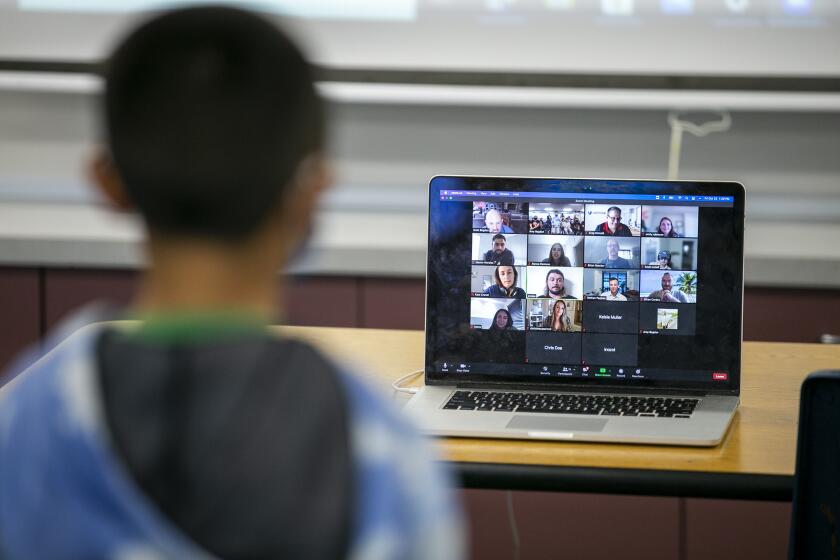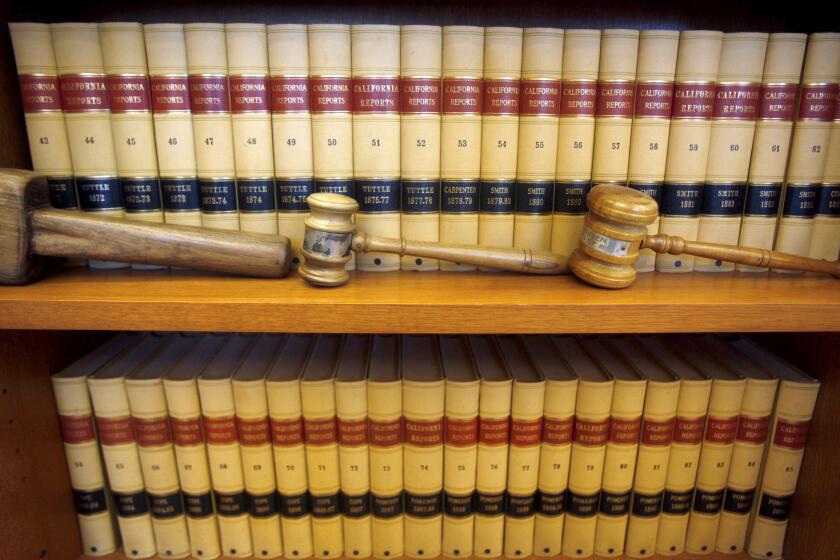Column: The human factor is key in protecting children
He looked to be about 2-and-a-half years old. I noticed him standing alone amid the throng at the busy swap meet at the Orange County Fairgrounds. When I got closer I could make out through his toddler babble two words he kept repeating: “Where Daddy?”
It was clear that the little guy had become separated from his father. I stayed by his side while my husband began circulating and calling out in case the dad was nearby. Soon, an obviously anxious man came running through the crowd and scooped the boy up in his arms. The relief was palpable among the many bystanders who had gathered around.
Another reminder of the fragility of childhood and the ease with which mishaps can occur. A father turns his back for an instant, and his son is gone. Haven’t we all experienced similar moments of panic at one time or another?
Keeping our kids safe is job No. 1 for parents, yet it can be so distressingly difficult despite our best efforts. Much as we might empathize, I hope that the young father from the swap meet episode resists the temptation to put his son on a leash.
Sometimes, in our quest to keep our kids safe, we end up veering astray. We worry about the wrong things, or focus on those that are least likely to cause harm. Some parents choose not to vaccinate their children, for instance, even though the risks of vaccinations are minuscule compared to the danger posed by the diseases they prevent.
And every time we hear about a terrible act of violence that has occurred at a school, our initial inclination might be to bubble wrap our kids and send them to an underground bunker.
It’s an understandable reaction, given that there have been hundreds of shootings on school campuses in the U.S. since the massacre at Sandy Hook Elementary school in Connecticut a little more than five years ago. Just last week two more of these shocking and senseless tragedies occurred at schools in Kentucky and Texas.
But while a siege mentality isn’t the answer, there are common-sense steps that can be taken to improve security.
Such thinking has driven school districts across the country to reevaluate their campuses and, in some cases, adopt design changes with enhanced safety features. Locked doors, lockdown drills, security cameras, and stricter check-in procedures are now common.
So far, it seems that Newport-Mesa Unified School District is taking a measured approach to such improvements.
The district began looking at this issue back in 1999 after the Columbine High School slaughter. Over the years, it has added fencing to those schools — Adams, Anderson and Victoria elementary schools — that previously had completely open perimeters. It then moved on to other campuses to augment, replace, or relocate fencing.
It is now planning this summer to replace chain-link fences at Wilson, Mariners and Newport Heights elementary schools with more-substantial iron fences.
The district has also studied the front office designs at these schools and concluded that all three offices should be reconfigured to improve outward visibility, while also avoiding a fortress-like appearance.
“We want to be welcoming,” said district spokesperson Annette Franco.
“We also want to make sure that whoever is supposed to be in is in, and whoever is supposed to be out is out and goes through the appropriate measures to check in.”
All well and good, and the $244,000 Newport-Mesa recently approved for the fence designs and office renovations appears to be a reasonable expenditure.
Even so, we should all be cognizant of the limitations of even the most well-designed physical barriers. Indeed, security experts repeatedly warn that schools often tend to overcompensate with physical security measures at the expense of the human element.
The most important safety features are counselors, psychologists, and school resource officers, these experts say. They are a well-prepared staff and trained crisis teams that meet and review plans regularly.
They are community members attuned to potential signs of trouble, such as students who are bullied, withdrawn, depressed, or chronically truant. They are environments in which kids feel they can trust adults with their concerns.
Consider the neighbors of the Perris couple who allegedly tortured and abused their 13 children. Those neighbors are now left to wonder whether they should have looked more carefully and asked more questions.
Or think of the parents of the young athletes who were molested by the USA Gymnastics team doctor. That doctor has been sentenced to 40 to 175 years in prison, but that’s probably cold comfort to his victims and their families.
One gymnast’s mother, whose daughter was abused by Nasser when she was just 8 years old, was reported to say, “To think I let this happen to my child when I was sitting right there … .”
One parent’s anguish is another’s reminder: Of all the safety precautions, the most important one is us. It is our eyes, ears, and intuition that can alert us, if we’re paying attention, when something is wrong.
PATRICE APODACA is a former Newport-Mesa public school parent and former Los Angeles Times staff writer. She lives in Newport Beach.
All the latest on Orange County from Orange County.
Get our free TimesOC newsletter.
You may occasionally receive promotional content from the Daily Pilot.




